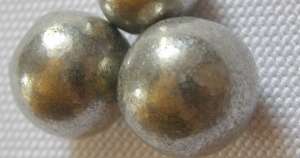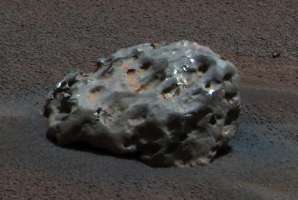Nickel (original) (raw)
Data Zone | Discovery | Facts | Appearance & Characteristics | Uses | Abundance & Isotopes | References
The chemical element nickel is classed as a transition metal. In the 1750s nickel was discovered to be an element by Axel Cronstedt.

Data Zone
| Classification: | Nickel is a transition metal |
|---|---|
| Color: | silvery-white |
| Atomic weight: | 58.693 |
| State: | solid |
| Melting point: | 1455 oC, 1728 K |
| Boiling point: | 2990 oC, 3263 K |
| Electrons: | 28 |
| Protons: | 28 |
| Neutrons in most abundant isotope: | 30 |
| Electron shells: | 2,8,16,2 |
| Electron configuration: | [Ar] 3d8 4s2 |
| Density @ 20oC: | 8.91 g/cm3 |
Show more, including: Heats, Energies, Oxidation,
Reactions, Compounds, Radii, Conductivities
| Atomic volume: | 6.59 cm3/mol |
|---|---|
| Structure: | fcc: face-centered cubic |
| Hardness: | 4.0 mohs |
| Specific heat capacity | 0.44 J g-1 K-1 |
| Heat of fusion | 17.48 kJ mol-1 |
| Heat of atomization | 430 kJ mol-1 |
| Heat of vaporization | 377.5 kJ mol-1 |
| 1st ionization energy | 736.7 kJ mol-1 |
| 2nd ionization energy | 1752.9 kJ mol-1 |
| 3rd ionization energy | 3393.4 kJ mol-1 |
| Electron affinity | 111.5 kJ mol-1 |
| Minimum oxidation number | -1 |
| Min. common oxidation no. | 0 |
| Maximum oxidation number | 4 |
| Max. common oxidation no. | 2 |
| Electronegativity (Pauling Scale) | 1.91 |
| Polarizability volume | 6.8 Å3 |
| Reaction with air | mild, w/ht ⇒ NiO |
| Reaction with 15 M HNO3 | passivated |
| Reaction with 6 M HCl | mild, ⇒ H2, NiCl2 |
| Reaction with 6 M NaOH | none |
| Oxide(s) | NiO, Ni2O3 |
| Hydride(s) | NiH |
| Chloride(s) | NiCl2 |
| Atomic radius | 135 pm |
| Ionic radius (1+ ion) | – |
| Ionic radius (2+ ion) | 83 pm |
| Ionic radius (3+ ion) | – |
| Ionic radius (1- ion) | – |
| Ionic radius (2- ion) | – |
| Ionic radius (3- ion) | 72 pm |
| Thermal conductivity | 90.9 W m-1 K-1 |
| Electrical conductivity | 14.6 x 106 S m-1 |
| Freezing/Melting point: | 1455 oC, 1728 K |

High purity nickel metal. Image Ref. (6)

Miners in Germany believed little fellows like this one had stopped them extracting copper and silver from nickel and cobalt arsenides. Fortunately George Brandt and Axel Cronstedt took a more scientific approach to the problem and discovered two new elements. Image by JNL.
Discovery of Nickel
Nickel is present in metallic meteorites and so has been in use since ancient times.
Artifacts made from metallic meteorites have been found dating from as early as 5000 BC – for example beads in graves in Egypt.(1)
Iron is the most abundant element in metallic meteorites, followed by nickel.
It was not until the 1750s that nickel was discovered to be an element.
In the 1600s, a dark red ore, often with a green coating, had been a source of irritation for copper miners in Saxony, Germany. They believed the dark red substance was an ore of copper, but they had been unable to extract any copper from it.
In frustration, they had named it ‘kupfernickel’ which could be translated as ‘goblin’s copper’ because clearly, from the miners’ point of view at any rate, there were goblins or little imps at work, preventing them extracting the copper.
Between 1751 and 1754, the Swedish chemist Axel Cronstedt carried out a number of experiments to determine the true nature of kupfernickel. (We now know that kupfernickel is nickel arsenide, NiAs.)
After finding that its chemical reactions were not what he would have expected from a copper compound, he heated kupfernickel with charcoal to yield a hard, white metal, whose color alone showed it could not be copper. Its properties, including its magnetism, led him to conclude that he had isolated a new metallic element.
Cronstedt named the new element nickel, after the kupfernickel from which he had isolated it. (2), (3), (4)
There is a satisfying symmetry in this discovery. Cronstedt was a pupil of George Brandt, who had discovered cobalt, which sits immediately to the left of nickel in the periodic table.
The names of both elements have their origins in the frustrations of miners caused by metal-arsenic ores: nickel arsenide and cobalt arsenide. Cobalt’s name is derived from the German ‘kobold’ meaning ‘goblin’ – a close relative of the creature from which nickel’s name was derived.
In cobalt’s case, miners mistakenly thought the ore contained silver, and called the ore kobold in frustration at the wicked goblins who they believed were preventing them getting silver from the ore.
In the early twentieth century, Ludwig Mond patented a process using nickel carbonyl to purify nickel. This process is still used today.
Interesting Facts about Nickel
- Nickel is ferromagnetic at room temperature, just like its close periodic table neighbors iron and cobalt.
- Nickel is 100 times more concentrated below Earth’s crust than in it. Nickel is believed to be the second most abundant element in the earth’s core, with iron most abundant by a large margin.
- Nickel is the main metal in Mu-metal, which has the fascinating property of magnetic shielding. Magnets will normally attract metals such as iron. If you place Mu-metal between magnet and metal, the attraction disappears. This is because very little magnetic field is transmitted through Mu-metal. Mu-metal is approximately 80% nickel, 20% iron with a little molybdenum. (5)
- The strange properties of nickel’s alloys don’t end with Mu-metal. Nitinol is a nickel alloy, discovered in the 1960s, that remembers its previous shape. Heat this 1:1 nickel-titanium alloy to about 500 oC, and bend it into whatever shape you like; you could bend a wire to make your name. Then cool it and bend the wire into a spring. Heat the wire again and, remarkably, the spring disappears, and the first shape – in this case your name – returns.
- Nickel is corrosion resistant – it is one of the elements used in stainless steel. The presence of nickel in meteorite metal means it would have stayed bright and shiny in the hands of ancient people for much longer than if nickel had been absent.
- Until the invention of rare-earth magnets, such as neodymium-iron-boron, the strongest permanent magnets – Alnico magnets – were made from a nickel alloy: mainly aluminum, nickel, cobalt and iron. Unusually, Alnico magnets retain their magnetism even when heated until they glow red hot.
- Supernova 2007bi was observed in 2007. One of the products of this supernova was nickel-56, synthesized during the explosion. Nickel of mass three times greater than our entire sun was made. Nickel-56 is radioactive, decaying to cobalt-56, which itself decays to stable iron-56.


The first meteorite ever photographed on another planet. In 2005 NASA’s Mars rover Opportunity used spectrometers to discover that this basketball-size meteorite was mainly iron and nickel. Image by NASA/JPL/Cornell.
How to make your own nickel-iron battery. These batteries last for decades!
Reaction of nickel metal with nitric acid producing nickel nitrate and brown nitrogen dioxide gas. For some reason the video says nickel nitrate is blue. It is in fact green, as you can see.
Appearance and Characteristics
Harmful effects:
Nickel and its compounds are considered to be carcinogenic. Approximately 10 to 20 percent of people are sensitive to nickel. Repeated contact with it leads to skin complaints (dermatitis). Such people should avoid contact with nickel, which can be found in jewelry.
Workers who have breathed very large amounts of nickel compounds have developed chronic bronchitis and lung and nasal cancers.
Nickel carbonyl is a very toxic gas.
Characteristics:
Nickel is a hard, silvery-white metal, which is malleable and ductile.
The metal can take on a high polish and it resists tarnishing in air.
Nickel is ferromagnetic and is a fair conductor of heat and electricity.
Most nickel compounds are blue or green.
Uses of Nickel
The majority of nickel is used in corrosion-resistant alloys, such as stainless steel.
Tubing made from a copper-nickel alloy is used in desalination plants. This alloy is naturally resistant to corrosion by seawater and to biofouling.
Many coins contain nickel.
Nickel steel is used for burglar-proof vaults and armor plate.
Nickel is also used in batteries – for example NiCd (nickel-cadmium) and Ni-MH (nickel-metal hydride) rechargeable batteries – and in magnets.
Abundance and Isotopes
Abundance earth’s crust: 84 parts per million by weight, 30 parts per million by moles
Abundance solar system: 80 parts per million by weight, 2 parts per million by moles
Cost, pure: $7.7 per 100g
Cost, bulk: $1.9 per 100g
Source: Nickel occurs occasionally free in nature but is mainly found in ores. Its chief ores are pentlandite and pyrrhotite (nickel-iron sulfides), garnierite (nickel-magnesium silicate), millerite (nickel sulfide) and niccolite (nickel arsenic).
Nickel is taken from its ores by roasting and reduction processes which produce a metal of over 75% purity. The Mond process is then used to purify the nickel further.
Isotopes: Nickel has 23 isotopes whose half-lives are known, with mass numbers 52 to 76. Naturally occurring nickel is a mixture of its five stable isotopes and they are found in the percentages shown: 58Ni (68.1%), 60Ni (26.2%), 61Ni (1.1%), 62Ni (3.6%) and 64Ni (0.9%). The most abundant isotope is 58Ni at 68.1%

References
- Henry Maryon, Early Near Eastern Steel Swords., 65, 1961, American Journal of Archaeology p1.
- William H. Baldwin, The story of Nickel. I. How “Old Nick’s” gnomes were outwitted., J. Chem. Educ., 1931, 8 (9), p1749
- Virginia Bartow, Axel Fredrick Cronstedt., J. Chem. Educ., 1953, 30 (5), p247
- Mary Elvira Weeks, The discovery of the elements. III. Some eighteenth-century metals., J. Chem. Educ., 1932, 9 (1), p22
- The MuShield Company
- Image by René Rausch
Cite this Page
For online linking, please copy and paste one of the following:
or
To cite this page in an academic document, please use the following MLA compliant citation:
"Nickel." Chemicool Periodic Table. Chemicool.com. 08 Oct. 2012. Web.
https://www.chemicool.com/elements/nickel.html.